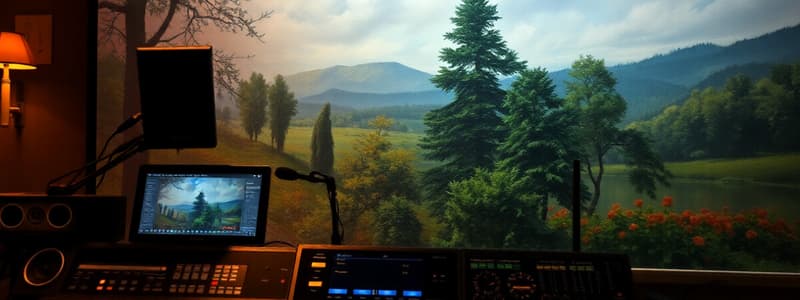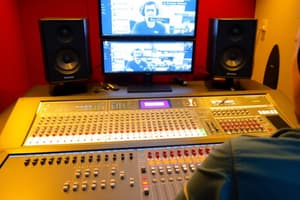Podcast
Questions and Answers
What are the two rules for arrangements in music mixing?
What are the two rules for arrangements in music mixing?
- Use only percussion and melodic elements together, and keep the volume levels uniform.
- Limit the tempo and limit the number of elements playing at the same time.
- Limit the number of elements playing at the same time and ensure all instruments play in the same frequency range. (correct)
- Allow all instruments to play freely and adjust the tempo as needed.
According to mixing engineers, where can one focus when starting a mix?
According to mixing engineers, where can one focus when starting a mix?
- Begin with the rhythm guitar and build around it.
- Focus on the keyboard riffs initially to set a melodic foundation.
- Start with the snare drum on the backbeat and construct the mix around that. (correct)
- Initiate with the vocals as the primary element to ensure clarity.
What should you monitor continuously to prevent issues while mixing?
What should you monitor continuously to prevent issues while mixing?
- The level of the vocal track primarily.
- The pitch and tonal quality of instruments in the mix.
- Your master bus meters to avoid overloads and clipping. (correct)
- The individual track meters for each instrument.
What is a beneficial practice when ensuring a mix is on track?
What is a beneficial practice when ensuring a mix is on track?
What is the primary starting point when mixing dance music?
What is the primary starting point when mixing dance music?
Which step is the most important when approaching a mix?
Which step is the most important when approaching a mix?
What does a great mixer aim for when creating a 'tall' dimension in a mix?
What does a great mixer aim for when creating a 'tall' dimension in a mix?
What is often considered the number one non-audio problem in a mix?
What is often considered the number one non-audio problem in a mix?
Which of the following is NOT a sign of an amateur mix?
Which of the following is NOT a sign of an amateur mix?
What techniques are used to achieve a 'deep' dimension in a mix?
What techniques are used to achieve a 'deep' dimension in a mix?
What does a mix lack if it has no contrast?
What does a mix lack if it has no contrast?
Which element is NOT considered part of the six elements of a great mix?
Which element is NOT considered part of the six elements of a great mix?
What should one do to make a great mix sound bigger than real life?
What should one do to make a great mix sound bigger than real life?
What should be done to ensure the monitoring system provides a better mix translation?
What should be done to ensure the monitoring system provides a better mix translation?
What is a key reason for not placing monitor speakers directly against a wall?
What is a key reason for not placing monitor speakers directly against a wall?
What is the first action recommended when working with an original session file?
What is the first action recommended when working with an original session file?
Why is it important to trim the heads and tails of takes?
Why is it important to trim the heads and tails of takes?
What is the primary purpose of using crossfades on edits?
What is the primary purpose of using crossfades on edits?
What should be done after completing all edits, comping, and tuning?
What should be done after completing all edits, comping, and tuning?
What is a benefit of clearly labeling each track in a session?
What is a benefit of clearly labeling each track in a session?
What should you be wary of regarding reflective surfaces in a listening environment?
What should you be wary of regarding reflective surfaces in a listening environment?
What is the ideal setup of monitor speakers in relation to the listening position?
What is the ideal setup of monitor speakers in relation to the listening position?
What is one consequence of having monitor speakers too close together?
What is one consequence of having monitor speakers too close together?
Why is it important to decouple monitor speakers from their surface?
Why is it important to decouple monitor speakers from their surface?
Which of the following is NOT a reason to avoid mixing at high volume levels?
Which of the following is NOT a reason to avoid mixing at high volume levels?
What is one advantage of mixing at low volume levels?
What is one advantage of mixing at low volume levels?
Why is it beneficial to listen to a mix in mono?
Why is it beneficial to listen to a mix in mono?
What is a reason for evaluating a mix on multiple speaker systems?
What is a reason for evaluating a mix on multiple speaker systems?
What is a potential outcome if monitors are placed too far apart?
What is a potential outcome if monitors are placed too far apart?
What is the primary benefit of using logical names for audio tracks in a DAW?
What is the primary benefit of using logical names for audio tracks in a DAW?
What is a key function of subgroups in a mix?
What is a key function of subgroups in a mix?
What should you avoid doing to maintain your hearing while preparing to mix?
What should you avoid doing to maintain your hearing while preparing to mix?
What technique do veteran mixers often employ during a mix?
What technique do veteran mixers often employ during a mix?
Why is it advised to have a pen and pad ready while mixing?
Why is it advised to have a pen and pad ready while mixing?
What effect does closing your eyes while mixing have on your perception?
What effect does closing your eyes while mixing have on your perception?
When channels are utilizing particular effects, what should be done with those channels?
When channels are utilizing particular effects, what should be done with those channels?
What is one common practice engineers employ at the beginning of a mix?
What is one common practice engineers employ at the beginning of a mix?
Flashcards
Monitor Placement
Monitor Placement
The ideal setup forms an equilateral triangle with the listener. Monitors should be at ear level, and angled to avoid stereo image distortion.
Monitor Distance Impact
Monitor Distance Impact
Placing monitors too close creates a narrow soundstage, while placing them too far apart can weaken the center image and shift the sweet spot.
Monitor Decoupling
Monitor Decoupling
Decoupling reduces resonance, which improves the accuracy of bass frequencies in mixes.
How to Decouple Monitors
How to Decouple Monitors
Signup and view all the flashcards
High Volume Mixing Issues
High Volume Mixing Issues
Signup and view all the flashcards
Low Volume Mixing Benefits
Low Volume Mixing Benefits
Signup and view all the flashcards
Listening in Mono
Listening in Mono
Signup and view all the flashcards
Multi-Speaker Mixing
Multi-Speaker Mixing
Signup and view all the flashcards
Defining The Song's Direction
Defining The Song's Direction
Signup and view all the flashcards
Biggest Non-audio Problem in a Mix
Biggest Non-audio Problem in a Mix
Signup and view all the flashcards
Balance
Balance
Signup and view all the flashcards
Frequency Range
Frequency Range
Signup and view all the flashcards
Panorama
Panorama
Signup and view all the flashcards
Dimension
Dimension
Signup and view all the flashcards
Dynamics
Dynamics
Signup and view all the flashcards
Interest
Interest
Signup and view all the flashcards
Naming Convention
Naming Convention
Signup and view all the flashcards
DAW Efficiency
DAW Efficiency
Signup and view all the flashcards
Subgroups
Subgroups
Signup and view all the flashcards
Aux Send
Aux Send
Signup and view all the flashcards
Dynamic Control
Dynamic Control
Signup and view all the flashcards
Hearing Calibration
Hearing Calibration
Signup and view all the flashcards
Visual Deprivation
Visual Deprivation
Signup and view all the flashcards
Notes and Ideas
Notes and Ideas
Signup and view all the flashcards
Why mix in mono?
Why mix in mono?
Signup and view all the flashcards
Why avoid placing monitors near a wall?
Why avoid placing monitors near a wall?
Signup and view all the flashcards
Why work on a copy of the original session file?
Why work on a copy of the original session file?
Signup and view all the flashcards
Why trim audio clips?
Why trim audio clips?
Signup and view all the flashcards
Why use crossfades in edits?
Why use crossfades in edits?
Signup and view all the flashcards
Why consolidate audio clips?
Why consolidate audio clips?
Signup and view all the flashcards
Why label tracks?
Why label tracks?
Signup and view all the flashcards
How to improve studio acoustics?
How to improve studio acoustics?
Signup and view all the flashcards
How does a Song Hook the Listener?
How does a Song Hook the Listener?
Signup and view all the flashcards
What are the Two Rules for Arranging Instruments?
What are the Two Rules for Arranging Instruments?
Signup and view all the flashcards
What is Lee DeCarlo's Starting Point for Mixing?
What is Lee DeCarlo's Starting Point for Mixing?
Signup and view all the flashcards
What does it Mean to "Keep an Eye on the Meters?"
What does it Mean to "Keep an Eye on the Meters?"
Signup and view all the flashcards
How do Reference Tracks Help in Mixing?
How do Reference Tracks Help in Mixing?
Signup and view all the flashcards
Study Notes
Monitoring Reading Assignment
-
Monitor Placement: Equilateral triangle setup; monitors at ear height when seated. Avoid "smearing" of stereo field.
-
Monitor Proximity: Monitors too close = narrow stereo image, weak center. Monitors too far apart = "sweet spot" behind listening position.
-
Decoupling Monitors: Essential for accurate bass response, reduces resonance by removing monitors from their support surface (e.g., using stands, rubber feet, sand-filled stands).
-
High Volume Mixing Issues: Avoid high volumes to prevent issues like ear fatigue, damage, skewed perception, and stereo imbalance.
-
Low Level Mixing Benefits: Low volume mixing is necessary for maintaining accurate hearing and judging fine detail, preserving hearing for lengthy sessions, and translating better to diverse listening environments.
-
Mono Mixing Usage: Checks for balance, panning issues, and phase in a mix; important if the mix will be reproduced on devices with a single speaker output.
-
Working with Original Session Files: Create a copy of the original session file, back up both copies to separate locations, and a cloud to avoid loss in case of unforeseen incidents.
-
Edit Consolidation: Consolidate clips after edits, comping, and tuning for easier session organization.
Labeling and Organizing Tracks
-
Track Labeling: Use logical names that follow conventions for easier collaboration, organization, and archival purposes (e.g., "acoustic_guitar-left.wav").
-
Mixing Efficiency: Using memory locations and configurations, and noting mix elements with pre-rolls is critical in efficient mixing.
Mixing Techniques
-
Subgroups in Mixing: Group similar elements for unified adjustment of effects like EQ and compression, improving efficiency.
-
Routing Audio Channels: Assign tracks with similar effects to subgroups. This makes adjusting effects (e.g., EQ or compression) global to a group effectively.
-
Dynamic Processing: Kick, snare, bass, and vocal tracks often require dynamic processing (compression) to control their dynamics range.
Mix Calibration and Preparation
-
Hearing Calibration: Calibrate hearing before mixing by relaxing in a quiet environment, considering diet, identifying loudest/softest sounds, and adjusting monitor volume to a lower point.
-
Visual-Auditory Awareness Tip: Closing eyes during mixing improves auditory awareness, enhancing sound space perception, balance, and clarity by eliminating visual distractions.
Mix Elements
-
Mix Contrast: Contrast in a mix is critical for separation and individual instruments.
-
Mix Clarity and Punch: The mix should have clarity and punch which means a mix should be clear and impactful (not muddy).
-
Consistent Levels: A mix should have consistent levels, especially with volume control.
Technical Aspects
- Arrangements Rule of Thumb: Limit simultaneous instruments (playing at the same time) and place instruments in accordance to their frequency range.
Studying That Suits You
Use AI to generate personalized quizzes and flashcards to suit your learning preferences.





